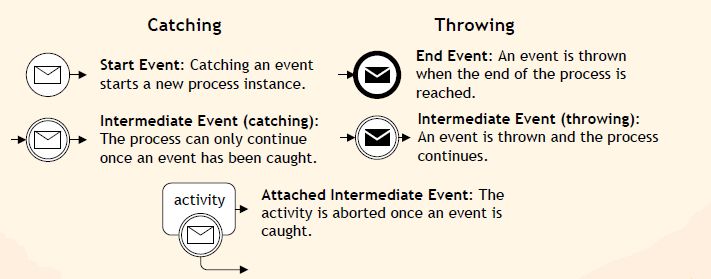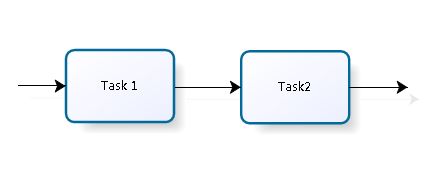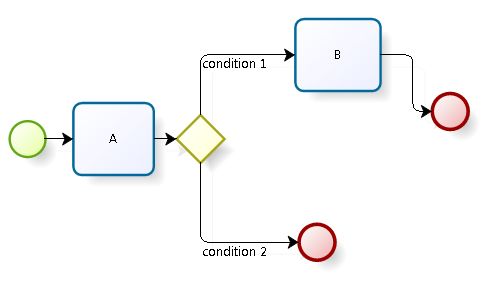On this page you will learn what the BPMN is.
Business Process Modeling Notation (BPMN) is a graphical representation for specifying business processes in a business process model. BPMN was developed by Business Process Management Inititaive. The objective of BPMN is to support business process management for both technical users and business users by providing a notation that is intuitive to business users yet able to represent complex process semantics.
The current version of BPMN is 2.0
Elements
- The four basic categories of elements are as follows:
- Flow Objects: Events,Activities,Gateways
- Connecting Objects:Sequence Flow,Message Flow,Association
- Swimlanes:Pool,Lane
- Artifacts (Artefacts): Data Object,Group,Annotation
Gateways
A Gateway is represented with a diamond shape and will determine forking and merging of paths depending on the conditions expressed.
Events
In BPMN,there are three types of events:
- Start event - acts as a trigger for the process;indicated by a single narrow border;and can only be Catch,so is shown with an open (outline) icon.
- Intermediate event -represents something that happens between the start and end events;is indicated by a tramline border;and can Throw or Catch (using solid or open icons as appropriate) –for example,a task could flow to an event that throws a message across to another pool and a subsequent event waits to catch the response before continuing.
- End event –represents the result of a process;indicated by a single thick or bold border;and can only Throw,so is shown with a solid icon.
- Catching –they might catch an incoming message to start the process.
- Throwing –they might throw a message at the end of the process.
Workflow Patterns
Worflow Patterns describe the behavior of business processes. The patterns range from very simple to very complex and cover the behaviors that can be captured within most business process models.
- WP1:Sequence
- WP2:Parallel Split
- WP3:Synchronization
- WP4:Exclusive Choice
- WP5:Simple Merge
- WP6:Multi-Choice
- WP7:Multiple Merge
- WP8:Discriminator
- WP9:N out M Join
- WP10:Synchronizing Merge
- WP11:Arbitrary Cycles
- WP12:Implicit Termination
- WP13 to 16:Multiple Instances
- WP17:Deferred Choice
- WP18:Interleaved Routing
- WP19:Milestone
- WP20:Cancel Activity
- WP21:Cancel Case
 What is the BPMN?
What is the BPMN?- What is the workflow pattern?
- What workflow patterns do you know?
Basic Patterns
of business processes.
previous activity has completed.
rather than serially. A single path through the process is split into two or more paths so that
two or more activities will start at the same time.
set of activities within the flows must be completed before the process can continue. This is the “synchronization”
of the parallel paths.
or more exclusive alternative paths. The pattern is exclusive in that only one of the alternative paths may
be chosen for the process to continue.
joined into a single path.
Questions
If you do not know the answer to these questions,read again the above content.













